| Biltur
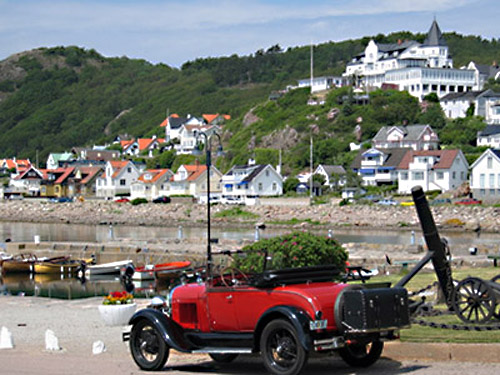
| | Via tekstikonet, nederst, gives der her en guide til en fire-dages familietur i den nordlige del af Øresundsregionen.
I venstremenuen kan man finde uddybende forklaringer fra Ørsundstids historiske materiale.
Man kommer tilbage til guiden ved at klikke på: "Bilturen" i venstremenuen.
God tur! |
En biltur med børn
Turforslaget henvender sig til familier med børn i den skolepligtige alder og beskriver fire dage i bil på begge sider af Sundet i den nordlige del af Øresundsregionen. Turen byder på masser af oplevelser og aktiviteter for hele familien. Man kan selvfølgelig også vælge kun at køre én af dagsturene.
I Øresundstids sidemenu kan man få den historiske baggrund for de enkelte destinationer.
Under Kort og Links finder man rutebeskrivelser og links til de enkelte besøgsmåls hjemmesider med oplysninger om åbningstider, priser m.m.
Dag 1
Turen starter i Helsingør, hvor der er mange forskellige overnatningsmuligheder. Bl.a. Helsingør Vandrerhjem, Helsingør Camping, diverse Bed & Breakfast og hoteller i alle prisklasser. Se evt. herom på Helsingør Turistbureaus hjemmeside. Under Kort og Links.
Første stop på turen er:
Esrum Kloster
Klosteret er fra midten af 1100-tallet, men er nu omdannet til et moderne museum, hvor de besøgende får et spændende indblik i middelalderens verdensbillede og levevis.
Der er arbejdende værksteder, middelaldermarked, hestevognsture og der arbejdes med skiftende middelaldertemaer.
Gå evt. på Esrum Klosters egen hjemmeside for at se de aktuelle temaer og tilbud. Se sidemenuen: Kort og Links
Næste stop er:

Esrum Kloster |
Nordsjællands Sommerpark
Nordsjællands Sommerpark er en forlystelsespark med et utal af fantasifulde forlystelser og aktivitetsmuligheder. Bl.a. vandland, dyrepark, gokartbane og fjernstyrede både.
Efter al den fysiske udfoldelse er tiden måske inde til at slappe lidt af.
Her er den nærliggende lille kystby, Gilleleje, et oplagt rejsemål.
Gilleleje
Gilleleje er en af Nordsjællands kendte badebyer. De idylliske omgivelser med havnen og den indbydende sandstrand har tiltrukket indenlandske og udenlandske turister i over 100 år.
Den storslåede udsigt til Kullen på den anden side af Sundet er med til at gøre Gilleleje populært.
Internationalt er Gilleleje også kendt for at være et af de største flugthavne for de danske jøder under 2. Verdenskrig. Gilleleje Kirkes loftsrum var i oktober 1943 tilflugtssted for ca.100 danske jøder, der blev opdaget af den tyske besættelsesmagt og sendt til tyske konzentrationslejre.
Man kan vælge at blive i Gilleleje til om aftenen og deltage i det traditionelle "moleræs" på den lange mole. Man kan også køre videre til naturområdet "Rusland" og se Rudolph Tegner Museet.
"Rusland" og Rudolph Tegners Museum
I et af Nordsjællands smukkeste landskaber kaldet: "Rusland", møder man et sælsomt syn. I det kuperede landskab dukker der et massivt, bunkerlignende byggeri op. Træder man indenfor, ser man en samling skulpturer med tydelige referencer til antikken.
Billedhuggeren, Rudolph Tegner (1873-1950) betalte selv for opførelsen af museet.
Flere af de bronceskulpturer som man kan se i Helsingør By er skabt af Tegner. F.ex. Danserindebrønden lige nord for Helsingør Værft og Herakles og Hydraen på Kronborgkajen i Helsingør Havn.
Dag 2
Bilturens anden dag byder både på slotsbesøg, naturoplevelser og besøg på et af Danmarks mest berømte kunstmuseer.
Frederiksborg Slot
Det imponerende renæssanceslot er opført i begyndelsen af 1600-tallet og er en af de ypperligste bygninger fra Christian 4.s regeringstid.
Slottet indeholder i dag, Det Nationalhistoriske Museum Frederiksborg Slot, med et spændende interiører, en omfattende historisk malerisamling og en stor samling personportrætter. Den imponerende barokhave er blevet genetableret, og hvis tiden er til det, kan man afslutte besøget med en lille sejltur på slotssøen med det gode skib, M/F Frederiksborg.

Frederiksborg slot |
Fredensborg Slot
En kort køretur fra slottet finder man:
Det lille slot er fra 1720,erne. Det smukke barokslot er i dag kongelig residens og danner bl.a. rammen om det danske kronprinspars bolig i Kancellihuset.

Fredensborg Slot |
Fredensborg Falkonergård
I umiddelbar nærhed finder vi:
Falkonergården er et helt unikt sted, hvis man vil opleve, hvordan mennesker og rovfugle, siden middelalderen, har arbejdet tæt sammen i jagten på et velsmagende måltid og børn og voksne kommer i tæt kontakt med luftens kongefugle.
Herfra går turen til det internationalt kendte Louisiana Museum for Moderne Kunst i Humlebæk.
Louisiana Kunstmuseum
Louisiana er et af Danmarks mest besøgte kunstmuseer. Det er meget smukt placeret i en park med skulpturer og en fantastisk panoramaudsigt over Sundet til Skåne. Udsigten kan også nydes fra cafeteriet og terrassen foran.
Museet viser nutidskunst fra hele verden, og børnene kan selv være kreative i museets eventyrlige børnehus.
Dag 3
Bilturens tredje dag begynder med sejlturen fra Helsingør til Helsingborg. Turen tager kun ca. 20 minutter med en af de store og velindrettede bilfærger, der sejler hvert 20 minut!
Dagens tur bringer familien ud i nogle af Skånes smukkeste naturområder.
Kullen
Længst ude på Kullahalvøen ligger naturreservatet Kullaberg. Udsigten og de dramatiske landskabsformationer har altid tiltrukket folk og længst ude på odden finder man Sveriges højest beliggende fyr. Fra fyret kan man følge en afmærket sti ned til den såkaldte ”Silvergrottan”. Den danske konge, Frederik II, som levede i 1500-tallet, troede, at han kunne udvinde sølv af en åre, man havde fundet i klippen. Den Nordiske 7-årskrig kom i vejen og man kom ikke i gang med ”udvindingen” før i 1571. Da viste det sig, at malmen fra ”Sølvhuggerhullet”, som man kaldte det, ikke indeholdt noget sølv og projektet blev opgivet. Det var en sølvskinnende bjergart, pegmatit, man havde fundet. Når man er inde i grotten, forstår man godt, at nogle kunne tro, at de sølvglitrende vægge indeholdt ædelt metal.

Kullen |
Nimis
På nordkysten af Kullaberg ved Skälderviken ligger Nimis, et kolossalt bygningsværk af drivtømmer, som kunstneren Lars Vilks har samlet og brugt til at skabe en højst besynderlig konstruktion. Man kan krybe gennem tunneler, klatre op i små tårne og vandre rundt i dette mærkværdige klatrestativ. Der er efter sigende brugt mere end 160000 søm til byggeriet. Stien til Nimis er fra Himmelstorps Hembygdsgård afmærket med ”N”. Man skal regne med, at det tager op til en time at gå derud. Vær også opmærksom på, at turen går gennem stærkt kuperet terræn og at man nogle steder kommer meget tæt på de stejle skrænter!
Tilbage på Hembygdsgården kan man få kaffe og kage på Himmelstorps cafè.
Ingelbo Moose Park
60 km øst for Helsingborg ved en lille by, der hedder Västre Torup, ligger Sveriges sydligste elgpark, Ingel Moose Park. Her kan man se ”dyrenes konge” og komme helt tæt på naturen.
Der er grillpladser og overnatningsmuligheder i parkens ”Bed & Breakfast”.
En populær måde at overnatte på er at ”bo på bondegård”.
Bo på bondegård
Som en hyggelig og anderledes form for natlogí kan det anbefales at Bo på bondegård.
Det plejer at være populært hos hele familien. Og under Kort og Links kan man finde en række tilbud på dette.
Dag 4
Bilturens 4. dag byder på naturoplevelser i området øst for Helsingborg.
Dræsinekørsel fra Nybygget og Ljungbyhed
Ved ledvogterhuset ”Lilla Kloster” på Vej 13 kan man bestille en helt speciel oplevelse. Man kan nemlig køre med dræsine på jernbanestrækningen mellem Nybygget og Ljungbyhed, en tur på 13 km tur/retur. Jernbanen går gennem et naturskønt område med meget vildt og man kan holde pause, hvor man vil. Det er bare at løfte dræsinen af sporet. Övad Skog er en rasteplads, der kan anbefales. Herfra er der en gåtur på 800 meter i nordlig retning til et oldtidsminde i en bøgeskov. Da restauranter ikke vokser på træerne i dette område, er det en god idè at have madpakker med.
Dinoland i Nyvång
På lang afstand ser man den enorme slaggebunke ved Nyvångs gamle kulgrube. Lige ved siden af den finder man Dinoland, som rummer en af verdens største samlinger af kopier af Dinosauruser i naturlig størrelse. Man skal vist være taknemmelig for, at den næsten tredive meter lange Tyrannosaurus Rex kun er en kopi og ikke et levende væsen. Man kan også gå op til udsigtspunktet oppe på slaggehøjen, besøge en lille forlystelsespark for børn, køre i tog gennem en eventyrskov eller øve sig i at køre Go-Cart.
Påarp Fuglepark
I Påarp lige uden for Helsingborg, ligger Sveriges største fuglepark. Her er flere hundrede arter fra hele verden, f.eks. araer, parakitter og kakaduer. Fuglene kan flyve rundt i en stor voliere på 33 x 10 meter.
Fugleparken er et velegnet udflugtsmål for hele familien. Børnene kan løbe rundt og lege i haven, passionerede ornitologer og glade fugleamatører kan samles omkring voliererne og alle kan nyde det berømte svenske kaffebord.
Der er overnatningsmuligheder i forbindelse med fugleparken og man kan også ”Bo på lantgård” i nærheden.
Dag 5
Bilturen afsluttes med en dag i Helsingborg.
Dropp In i Helsingborg
Dropp Inn er et oplevelsescenter med spændende aktiviteter for både børn og voksne. Temaet er vand og man kan selv udføre forskellige eksperimenter. Selvfølgelig kan man også bruge tiden på at blæse sæbebobler og udnytte de mange andre legemuligheder.
Med lys- og lydspil og computere som pædagogiske hjælpemidler kan man følge vandets veje både i naturen og i byen.
Udenfor er der andre muligheder. Man kan f.eks. sejle med fjernstyrede både, køre i el-biler eller lege i eventyrparken.
Helsingborgs Tropikarium
Nogle hundrede meter nord for Olympia, lige ved Frederiksdal, ligger Tropikariet. Her kan man se lemurer, anakondaer, krokodiller, skildpadder, skorpioner, dværgsilkeaber og meget mere. Vil du have en spændende zoologisk oplevelse, skal du besøge Tropikariet.
Väla Centrum
Det er let at komme til Väla, det nordvestlige Skånes største indkøbscenter, nogle kilometer uden for byen. Over 100 butikker og gode parkeringsforhold lokker hver dag kunder til fra nær og fjern.Kort og Links
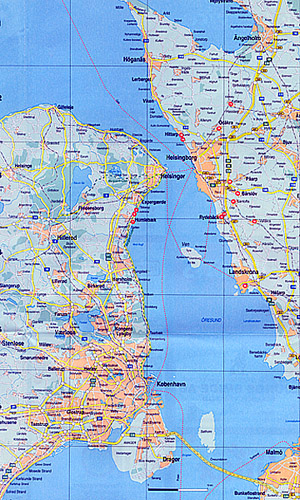
| | Forslaget til en ca. 4- dages biltur i den nordlige del af Øresundsregionen
er en oplevelsestur for hele familien.
På linkikonet nedenfor kan man evt. orientere sig i de enkelte besøgsmåls egne hjemmesider med åbningstider, priser, booking etc.
Man kommer tilbage til guiden ved at klikke på: "Bilturen" i venstremenuen.
(Nyt kort under produktion) |
Esrum Kloster
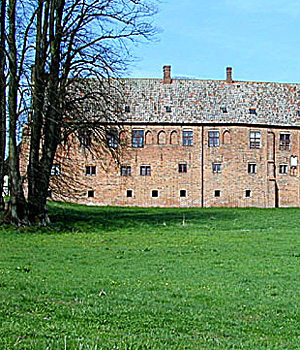
| | Esrum kloster bliver i løbet af middelalderen den største jordbesidder i Nordsjælland.
Den tidlige middelalders stordrift på såkaldte grangier med lægbrødres arbejdskraft afløses af et system med brydegårde med tilknyttet arbejdskraft i skikkelse af gårdsæder (husmænd) og landboer (fæstebønder). |
Esrum Kloster i Nordsjælland blev etableret som cistercienserkloster i 1151 og knyttes til hovedklosteret Clairveaux i Frankrig, opkaldt efter reformatoren Bernard af Clairveaux. Endnu i dag aner man klosterets ideelle beliggenhed, isoleret på en flad strækning tæt ved Esrum Sø og op til åen, der kunne forsyne klosteret med drikkevand og vandkraft. Esrum Kloster blev fra starten begunstiget med gaver i form af jord og ejendom og udviklede sig i løbet af 1200-tallet til den største jordejer i Nordsjælland.

Esrum Kloster | 
Vandvejen | 
Esrums beliggenhed | 
Bernhard af Clairvaux |
Bryde- og fæstegårde
I en første periode frem til midten af 1200-tallet blev vægten lagt på produktion på store avlsgårde, såkaldte grangier, der blev drevet af munkene og klosterets lægbrødre. Disse fungerede primært som klostrets håndsarbejdere og deltog kun i begrænset omfang i klosterlivet. Lægbrødre- ordningen har formodentlig også været et værn mod fattigdom i tider med rigelig arbejdskraft.
Cistercienserordenen skulle ikke betale tiende og den jord som munkene arvede og selv dyrkede var i det hele taget fritaget for skat, så grangiesystemet har været givtigt og fordelagtigt. Fra omkring midten af 1200-tallet bliver det svært at hverve lægbrødre og man begyndte at afvikle grangierne til fordel for brydegårde, gårde med bestyrere og tilknyttede gårdsæder(husmænd). Omkring dette tidspunkt ophæves endvidere en intern regel om at ordenes jord ikke må bortfæstes og herefter følger også oprettelse af fæstegårde med landboere(fæstebønder).
Dyrkningsstrukturen
Dyrkningsstrukturen med brydegårde og 3-vangsbruget eksisterede i hvert fald i den vestlige del af Nordsjælland, Holbo Herred, hvor den bedste jord befandt sig. I øvrigt må man i Nordsjælland forestille sig en meget varieret produktion med udgangspunkt i en slags skovlandbrug, hvor, som tidligere nævnt, adskillelsen imellem agerland og skov var flydende og høslæt og græsning for dyrene har spillet en hovedrolle.
Produktion og kost
Naturalielandgildens sammensætning og klosterbesiddelsernes beliggenhed i Nordsjælland viser en tendens til at den vegetabilske produktion dominerer i de nordlige og vestlige dele, mens den animalske produktion dominerer omkring Nødebo i bunden af Esrum Sø, hvor der har været engdrag til græsning omkring søen. På Nordkysten omkring Hornbæk spillede fiskeproduktionen en vis rolle.
Det er imidlertid vanskeligt at sige noget præcist om levevilkår og ernæring, men en enkelt kilde, den såkaldte "Skånske ledingsret", oplyser indirekte om kostens sammensætning.

Esrums produktion |
Klosterets besiddelser
Esrumklosters besiddelser strakte sig helt ud til Øresundskysten, hvor udnyttelse af vandkraft til møller fandt sted omkring det nuværende Egebæksvang.
Klosterets besiddelser begrænsede sig imidlertid ikke kun til Sjælland. Foruden de ialt 311 fæstegårde man besad, ejede klosteret en hovedgård og 45 fæstegårde i Halland. og et ukendt antal gårde i Skåne. Endvidere besad klosteret en mølle i Helsingborg og samme sted 2 boder, som man havde fået testamenteret som gave.
I Halland havde man interesser i tømmer, bl.a. egetræ, der allerede i 1100-tallet var ved at blive en mangelvare på Sjælland.Gilleleje
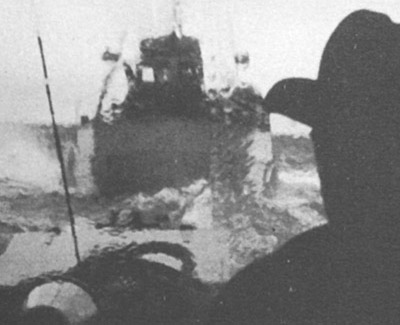
| | Gilleleje er, udover at være et pragtfuldt badested og sommerhusområde, også kendt for at være ét af de vigtigste flugtcentre for danske jøder, der søgte redning i Sverige under den tyske jødeforfølgelse under 2.Verdenskrig.
Dette skete ikke uproblematisk. Den største tragedie udspillede sig på Gilleleje Kirkes loft, hvor tyskerne omringede ca. 100 danske jøder og førte dem til kz-lejre i Tyskland. |
Den store flugt - Danmark
Tusindvis af danskere flygtede i oktober 1943 over Sundet til Sverige. En hel del fra Gilleleje, Helsingør, Snekkersten og Espergærde.

Flugt over Sundet |
Optakten
Kort tid efter besættelsen forbød den tyske besættelsesmagt rejser mellem de skandinaviske lande, med mindre tyskerne selv accepterede dette. For at administrere og kontrollere forbudet forlangte tyskerne at:
-Der skulle søges visum, som danskerne selv skulle administrere, men under tysk kontrol.
-Der skulle oprettes et dansk kystpoliti til patrulje af de østvendte danske farvande fra Hundested i nord til Gedser i syd.
-Den danske marine skulle kontrollere de tilstødende farvande.
I begyndelsen voldte restriktionerne ikke de store problemer. Fra Danmark blev besat den 9.april 1940 til august 1943, kom der nemlig kun få flygtninge fra Danmark til Sverige. Dels på grund af de relativt fredelige forhold i Danmark, men også på grund af den restriktive flygtningepolitik i Sverige. Af svenske politirapporter fremgår det således, at den svenske neutralitetspolitik over for det stærke og sejrrige Tyskland betød, at svenskerne ofte sendte danske flygtninge tilbage til Danmark.

Kystpolitiet |
Vendepunktet
Efter en række store strejker og protester mod den danske regerings samarbejdspolitik, indgav regeringen d. 29.august 1943 sin afskedsbegæring til kongen, Chr. X. Denne undlod at behandle sagen, hvilket betød, at ministrene formelt set fortsat styrede Danmark og fik deres løn og pension besættelsesperioden ud. I praksis satte de embedsmændene i ministerierne til at stå for de daglige rutiner.
Besættelsesmagtens svar kom omgående: Internering af det danske militær og oprettelse af tyskdominerede terrorbander, som bl.a. udførte såkaldte clearingdrab, hver gang der fandt angreb sted på tyske interesser.
Flygtningestrømmen vokser
I lyset af disse begivenheder voksede antallet af flygtninge i september 1943 til 609, hvoraf de 61 var jøder. Resten var først og fremmest militærpersoner, modstandsfolk, statsløse personer, politifolk, men også eventyrere, der flygtede fra det mørklagte og restriktionsplagede Danmark.
En række kunstnere og intellektuelle, heriblandt en del jøder, begyndte at se skriften på væggen og arrangerede allerede i september 1943 overfarter til det neutrale Sverige.
Blandt dem var atomfysikeren Niels Bohr, arkitekterne Poul Henningsen og Arne Jacobsen. Arne Jacobsen var af jødisk oprindelse og Poul Henningsen stod på listen over clearingsofre, hvad han dog ikke selv vidste. De havnede begge sikkert i Stockholm, hvor de tilbragte resten af krigen.
Den 2. oktober 1943
Indtil slutningen af september 1943 følte de ca. 7.000 danske jøder sig forholdsvis sikre i Danmark. 99% havde således valgt at blive. Tre uger senere befandt langt de fleste sig i Sverige. Først og fremmest takket være en omfattende indsats fra danske medborgere.
Interne politiske magtkampe mellem den tyske besættelsesmagts repræsentanter i Danmark og hovedkvarteret i Berlin var også en medvirkende årsag til, at så mange undslap. Det er således en kendsgerning, at den tyske flådeattache von Duckwitz, sandsynligvis på foranledning af den tyske øverstkommanderende Best, lod oplysninger om den forestående aktion sive til den fremtrædende socialdemokrat og senere statsminister Hans Hedtoft, som advarede de jødiske kredse i København.

Werner Best | 
Duckwitz |
Den danske jødeforfølgelse
Natten mellem den 1 og 2.oktober 1943, iværksatte tyskerne en klapjagt på jøderne i Danmark. Officielt forklarede tyskerne overgrebet i dagspressen med de danske jøders skyld i augusturolighederne. For at få ”pillen til at glide ned”, løslod de samtidig de afvæbnede og internerede danske soldater.
Resultatet blev, at man i løbet af efteråret 1943 pågreb ca.600 jøder. De blev sejlet til Tyskland og 53 af dem døde i kz-lejren Theresienstadt. Det danske folketingsmedlem Martin Nielsen var øjenvidne til den modtagelse de danske jøder fik ved landgangen i Tyskland.

KZ-lejre i Europa | 
Theresienstadt | 
Martin Nielsen |
Sverige ændrer holdning
I lyset af begivenhederne i august måned, og tyskernes nederlag på østfronten og i det nordlige Afrika, tog den svenske stat sin neutralitetspolitik op til nyvurdering.Den 2.oktober 1943 meddelte Sverige således officielt, at de ville modtage de danske jøder som flygtninge. I tæt samarbejde med –især Skånes myndigheder og administration, blev der herefter etableret en række illegale flugtruter langs hele den sjællandske østkyst.
Den civile modstand
Jødeforfølgelserne betød et vendepunkt i mange danskeres holdning til den tyske besættelsesmagt. De danske jøders, historisk betingede, tætte integration i det danske samfund betød, at nazismens racepolitik krænkede mange danske borgeres retsbevidsthed. Større dele af befolkningen gik nu aktivt til modstand; ofte borgere uden tilknytning til den eksisterende del af modstandsbevægelsen.
I København strejkede studenterne i protest mod jødeforfølgelsen, og nogle af dem iværksatte, med stor succes, en indsamling af økonomiske midler til hjælp for jøderne: Omkring 1 million kroner, (Omregnet til 1993 kr. ca. 20 millioner kroner.)
Flugtruterne
De jødiske medborgere søgte nu i tusindtal fra København mod Øresundskysten, hvor der i de første dage herskede totalt kaos med hensyn til organisering af denne folkevandring. Flugtruter opstod spontant og i første omgang uden indbyrdes forbindelse.
Vidt forskellige mennesker gav sig enkeltvis, eller i grupper til at organisere flugtruter fra hovedstadsområdet til den svenske kyst. Aktiviteten strakte sig sydpå fra Møn til Holbæk. De fleste kom over fra København, men også Gilleleje på Nordkysten og Snekkersten syd for Helsingør blev i en periode veritable flugtcentre.
I Stockholm tog den danske arkitekt Ole Helweg initiativ til et møde med den svenske udenrigsminister og Ebbe Munck, der var den danske modstandsbevægelses repræsentant i Sverige. Og med hjælp fra jødiske kredse i Sverige blev der anskaffet en båd, der sattes i sejlads fra Malmö og blev starten på Den dansk-svenske Flygtningetjeneste, som i alt kom til at sejle 367 ture med flygtninge.

Hvorfra? | 
Ebbe Munch |
Vellykket redningsaktion
Resultatet blev, at langt de fleste, ca. 95%, af Danmarks ca. 7.000 jøder, i løbet af oktober måned kom i sikkerhed på den anden side af Sundet. Ca. 2-3000 direkte fra København, hvor omkring 80 % af jøderne boede.
Det var de privatbaserede flugtruter, bl.a. i Nordsjælland, der sikrede, at de danske jøder overlevede. Redningsaktionen for de danske jøder er, i den vestlige verden, senere blevet berømmet som noget enestående i forhold til den skæbne resten af Europas jøder led.Frederiksborg Slot
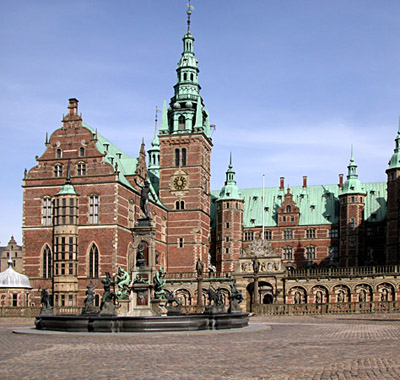
| | Frederiksborg Slot er oprindeligt opført i Frederik 2.s tid, men Chr. 4. påbegyndte i 1600-tallet en omfattende ombygning og satte sit eget præg på slottet.
I 1720,erne fik Frederik 4. etableret en imponerende barokhave, der som den eneste kongelige slotshave undgik at blive forvandlet til en romantisk have.
I 1996 blev den oprindelige tilgroede barokhave genetableret. |
Det ny Frederiksborg
Christian 4. fortsatte sin fars byggeiver i Nordsjælland, hvor han omkring år 1600 starter på at ombygge og udbygge Frederiksborg Slot. Arbejdet pågår over en årrække frem til 1626, hvor det står færdigt. I modsætning til Kronborg, der fremstår som en lukket befæstning, er Frederiksborg Slot åbent på bagsiden ud imod gården, hvor vandkunsten og de bagved liggende bygninger indgår i et samlet, mere åbent og repræsentativt anlæg, der således har mere moderne karakter: Slottet har mistet sin betydning som borg og befæstning, det tjener til præsentation af kongemagten.

Frederiksborg Slot | 
Pragtslottet | 
Audiensporten | 
Jerngitter | 
Frederiksborg Slot |
Renæssancestilen
Stilarten i byggeriet ved Frederiksborg, og en lang række andre af Christian 4´s byggerier, er nederlandsk renæssance med tårne, spir og rigt dekorerede gavlender. I Christian 4´s byggerier udvikles den karakteristiske blanding af røde teglsten og dekorative sandstensbånd og indramninger som ses på adskillige kongelige og adelige byggerier i samtiden.
Ligesom Frederik 2.anlagde et lysthus ved Marienlyst i Helsingør, opfører Christian 4. ved siden af selve slottet bygningen Sparepenge og også Badstuen, hvor det var mere bekvemt at opholde sig.

Frederiksborg slot | 
Badstuen | 
Trefoldighedskirken |
Frederiksborgs barokhave
Allerede i 1702 begyndte kongen at overveje at fjerne Sparepenge og den tilhørende have for at udnytte det skrå terræn på den anden side af slotssøen til anlæggelse af en større barokhave. 1720 begynder kongen at virkeliggøre sine planer. Sparepenge bliver brudt ned og en del af stenene herfra anvendes til opførelsen af Fredensborg Slot. I årene 1720-25 opføres den nye have efter plan af arkitekten Johan Cornelius Krieger.
Anlægget er på 100x 400 meter, anlagt i tre planer på det skrånende terræn. Venstre side af anlægget er koncentreret om en midterakse, der udgøres af en gennemgående vandkaskade. Anlægget omkring denne akse er symmetrisk beplantet, hvor de lave parterre-bede på første trin udgøres af varierede kongelige monogrammer.

Frederiksborg slotshave | 
Frederiksborg Slots omgivelser |
Genskabelsen
Som den eneste af kongehusets slotshaver undgik barokhaven ved Frederiksborg Slot at blive omlagt til romantisk landskabshave. Det har formentlig været for vanskeligt og forbundet med store omkostninger at fælde de mange lindealléer og ændre det karakteristiske terrasseformede terræn.
Siden 1850 har der været ønsker om at bringe den tilvoksede og forfaldne barokhave tilbage til tidligere tiders pragt. I 1993 lykkedes det endelig at tilvejebringe det økonomiske fundament, og den 5. juni 1996 blev J.C. Kriegers genskabte barokhave indviet.
I parterret har man plantet 65.000 buksbomplanter og 166 pyramideformede taksplanter. 375 lindetræer og 7.000 avnbøgplanter er anvendt til alléer og bosqueter. Til kaskadens dæksten er brugt 500m tilhuggede granitsten. I sommerperioden er kaskaden i drift, og haven viser sig fra sin smukkeste side.Fredensborg Slot
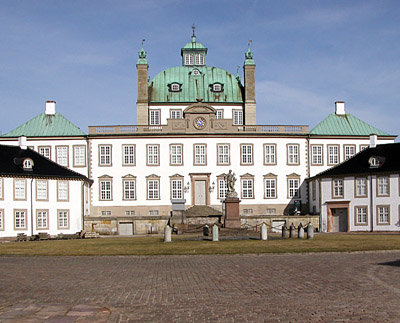
| | Efter afslutningen på Den store Nordiske Krig i 1720 synes man i Danmark endeligt at have opgivet tanken om at få Skånelandene tilbage. I hvert fald er fredstrangen så stor, at kongen ved anlæggelse af en ny residensbolig mellem Frederiksborg og Kronborg vælger at kalde denne for Fredensborg og ifølge overleveringen var det de penge, der var afsat til krigen, som anvendtes til byggeriet. |
Europas stormagter dominerer
Ved fredslutningen efter Den store Nordiske krig i 1720 var de to dobbeltriger Danmark-Norge og Sverige-Finland vel stort set jævnbyrdige, men også reduceret til brikker i er internationalt spil, der var domineret af de europæiske stormagter Frankrig, England, Holland og efterhånden også Rusland og det tyske område (Preussen), hvor samlingsbestræbelser tager fart i løbet af 1700-tallet.
Fredensborg: Et fredssymbol
I Danmark synes man efter Den store nordiske Krig endelig at opgive tanken om at få Skånelandene tilbage igen. I hvert fald er fredstrangen så stor at kongen ved anlæggelse af en ny residensbolig mellem Frederiksborg og Kronborg vælger at kalde denne for Fredensborg og ifølge overleveringen var det de penge, der var afsat til krigen, som anvendtes til byggeriet.
Hvor Fredensborg Slot nu ligger lå tidligere en jagtejendom eller lystgård med navnet Østrupgård, hvor kong Frederik 4.. gerne tilbragte tiden i stedet for det prangende Frederiksborg Slot. I 1719, da man efterhånden kunne skimte afslutningen på Store nordiske Krig, lader kongen bygge en kalkovn, ryddede veje og skove som forberedelse til en nyopførelse på stedet. Allerede i 1722 står hovedbygningen færdig og nybygningen får navnet Fredensborg, hvilket henviser til fredslutningen efter den store krig. Oprindelig var det da også tanken at kuplens lanterne på hovedbygningen skulle have været en statue antagelig af fredsgudinden.

Fredensborg Slot | 
Set fra parken |
Barok med renssancepræg
Det oprindelige anlæg bestod af den anseelige hovedbygning med kuppelsal, som endvidere udgjorde den ene side i et ottekantet anlæg, som tillige med nogle fritliggende bygninger opføres under den senere landbygmester J. C. Krieger, som på daværende tidspunkt var gartner ved orangeriet i Rosenborg Have.
Forbilledet er måske den franske konges lystslot Marly, som kongen havde set på den første af sine udenlandsrejser i 1691-92. I det ydre har slottet imidlertid ikke meget til fælles med den overlæssede franske barokstil. Fredensborgs glatte murfacader genfindes på Frederiksberg Slot. Kun de brede vinduesindfatningerne med overliggende frontoner fungerer dekorativt, men de ligner mest af alt vinduesindfatningerne på Kronborg, som er i renæssancestil. Trods disse renæssanceindslag er hovedindtrykket dog iflg. "Slots- og Ejedomsstyrelsen", barok:
"Det smukke 1700-tals barokslot danner ofte rammen om større officielle statsbesøg og familiebegivenheder i kongefamilien."
Den tillempede renæssancestil er da også ganske særegen og har mest lighed med stilen på Stockholm Slot, der er opført af den berømte svenske arkitekt Nicodemus Tessin den yngre. Formodentlig er inspirationen gået via den senere landbygmester Johan Conrad Ernst, der i 1697 opholder sig hos Tessin i Stockholm for at sætte sig ind i konstruktionen af et residentsslot, som Christian d. 5. havde tænkt at opføre i Amalienborg Have i København. På denne måde er opførelsen af Fredensborg Slot et vidnesbyrd om den kulturelle udveksling imellem de to lande, som bestod på trods af krig og uenighed.

Det oprindelige udkast | 
Døre og vinduer |
Jardins indflydelse
Efter Fredensborgs opførelse i 1723 kommer snart alle betydelige arkitekter i århundredet i berøring med byggeriet i forbindelse med udvidelser og ændringer, som dog heldigvis ikke spolerer slottets oprindelige karakter. Sidst, men ikke mindst, er den franske arkitekt N.H. Jardin involveret i planer for en større ombygning af selve slottets hovedbygning og haven, som omlægges over en årrække fra 1759-68. Størstedelen af de øvrige projekter opgives da kongen omkring 1762 skal bruge flere penge på oprustning på grund af modsætningsforhold til Rusland.

Fredensborg 1729 | 
Jardins plan 1760 | 
Normandsdalen |
Kullen
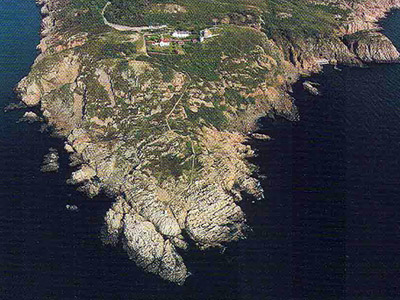
| | Kullen kaldes det bjerg, som ligger på Kullahalvön i nordvestre Skåne. Kullens yderste spids afgrænser Øresund fra Kattegat.
Området omkring Kullen, Kullabygden, blev et populært mål for 1800-tallets turister og de små fiskerlejer Arild og Mølle forvandledes til turiststeder.
Kullabygden er ofte betegnet som: "Den skånske riviera". |
Kullen-Arild og Mølle
Det smukke og dramatiske landskab på det langstrakte Kullaberg i Skåne , blev, allerede i 1800 tallet, et yndet udflugtsmål for sommergæster fra begge sider af Sundet.
Kunstmalerne var de første, der følte sig tiltrukket af den romantiske natur, men hurtigt fulgte litteraterne efter, og senere blev området et yndet sommerlandsted for den lidt mere velhavende del af befolkningen. De gamle fiskerlejer, Arild og Mølle, i udkanten af det vestlige og østlige område, blev, med deres pitoreske småhuse og nærhed til vandet attraktive udflugtsmål.
Kullaberg er ikke mere end 187 meter højt, men det faktum at det rejser sig direkte op fra havet bevirker at terrænformationen er opsigtsvækkende. Selve bjerget er 16 km langt og de fleste steder ca. 2 km bredt. Yderst mod havet afsluttes bjerget med en brat skrænt.
Kullens stejle skrænter mod det farlige hav på begge sider og de mange grotter har, fra Arilds(!) tid, naturligvis skabt grobund for for utallige folkesagn og myter.

Kullaberget | 
Silvergrotten udefra | 
Silvergrottens udsigt | 
Silvergrotten |
Palnatokes skiløb og Kullenmanden
Under romantikken vågnede interessen for de gamle nordiske folkesagn. En del af dem var knyttet til Kullaberg. Allerede i 1809 skrev Adam Oehlenschläger således tragedien ”Palnatoke” og bragte hermed atter liv til Saxos fortælling om den gamle danske sagnfigur. Palnatoke skulle, for att bevise sin formåen i skisport over for Harald Blåtand, have foretaget et styrtløb ned ad Kullens skrænter. (En bedrift som mange danskere, i lidt mindre målestok, den dag i dag, forsøger at efterligne ved halsbrækkende bjergklatringer)
Bernhard Severin Ingemann berettede i sin bog ”Valdemar Sejr” om "Kullamannen", som spåede om Valdemar Sejrs sønners fremtid.
Kullenmanden var en blandning af et slags naturvæsen og en autentisk historisk person på Kullen. Ifølge traditionen skulle det være en ridder ved navn Thord Knutsson Bonde.

Palnatokes skrænt |
Kullabergets romantiske navne
Den national- og naturromantiske interesse fremgår tydeligt i de navne, som man i 1800-tallets sidste halvdel gav klippeformationer og grotter på Kullaberg. F.ex. Kullamannens grav, Valdemarsgrotten og Palnatokes skrænt for slet ikke at tale om de smukt klingende navne: Kaprifoliegrottan, Paradiset, Josefinelust, og Silvergrotten. Josefinelust er opkaldt efter Oskar I:s hustru Josefin, som besøgte stedet.

Josefinelust | 
Josefinelustgrotten |
Arild, tidlig kunstnerkoloni
På Kullabergs østside finder vi det gamle fiskerleje Arild med udsigt over Skälderviken, Bjärehalvön og Kattegat. Det behagelige klima, den romantiske og idylliske atmosfære med det lidt bortgemte fiskerleje og lyset fra havet bidrog og bidrager stadig til stedets attraktionskraft.
Allerede i 1830,erne blev en række skandinaviske kunstmalere fascineret af Arilds landskabelige skønhed og de skabte efterhånden et frugtbart kunstnermiljø, hvor bl.a. de to fremtrædende landskabsmalere, danskeren Frederik Christian Kiaerskou og nordmanden Adolf Tidemand havde deres staffelier stillet op.

Arild - en idyl | 
Arilds Havn | 
Arild-fiskere | 
Arilds Havn 2006 |
Mor Cilla
I midten af 1800-tallet fik Arild et populært samlingspunkt for byens fiskere og de tilrejsende kunstnere og sommergæster. Det var den handlekraftige og bramfrie, Cecilia Andersson, som omdannede sit store hjem til et gæstgiveri, som hun kaldte, Mor Cilla.
Huset findes endnu i en fuldstændig forandret ombygning, men blev dengang et centrum for kunstnerisk virksomhed og selskabelighed. En slags forløber til det nok så berømte Brøndums hotel i Skagen.Blandt kunstnerne var også Natanael Beskow. som i september 1891 portræterede Mor Cilla på en af dørene på hotellet. Portrættet kan ses endnu. Traditionen, hvor kunstnerne betalte værten med billeder var Mor Cilla fuldstændig fremmed. Der skulle penge på bordet. Historien melder ikke noget om, hvorvidt, der blev gjort en undtagelse i Beskows tilfælde!
Mor Cillas status som fiskerlejets ukronede dronning i 1890,erne blev endeligt slået fast da Kong Oscar II besøgte Arild i 1894. Frokosten blev indtaget hos Mor Cilla. For bordenden tronede kongen og borddamen-ja, det var Mor Cilla!

Mor Cilla | 
Hotel Mor Cilla | 
Oskar II:s besøg | 
Kongebrev |
Danske kunstnere i Arild
Peter Severin Kröyer,der blev en af de kendteste Skagensmalere, opholdt sig allerede i 1872 i Arild og genbesøgte stedet i både 1881 og 1885. En hel del af hans værker herfra kan nu beses på Skagens Museum.
De naturalistiske tegninger af det fattige fiskerlejes befolkning viser tendensen til at fjerne sig fra forrige periodes romantiske skildringer.
En anden flittig sommergæst blandt kunstnerne var Viggo Pedersen, som også oprettede og ledede en kunstnerskole. Antallet af danske Arildskunstnere er anseeligt, men man kan bl.a nævne August Jerndorff och Bernhard Middelboe.
Når man ser, hvordan mange af de danske kunstnere samledes i Arild, Hornbæk og Skagen er det tydeligt, at det er de små fiskerlejer, der ofte skabte inspirationen.

P.S.Krøyer | 
Mor Cilla | 
Pige fra Arildsleje 1872 | 
Arild-skomager 1872 |
Svenske kunstnere i Arild
De svenske kunstnere kom også til Arild og Mor Cilla, men i reglen kom de senere end de danske. Carl Fredrik Hill besøgte Arild i 1870, 72 og 73, men de fleste svenskere kom dog først et stykke ind i 1880-talet. Richard Bergh, senere chef for Sveriges Nationalmuseum, kom til Arild første gang i 1884, Gustaf Cederström kom på sit første sommerbesøg her i 1887. Fritz von Dardel var i Arild 1891, hvor han bl. a. tegnde en tegning fra Mor Cillas 65-årsdag. Den måske flitigste kunstnersommergæst var Gustaf Rydberg, som boede i Arild hver sommer fra 1889 till 1909.
Mange kvindelige kunstnere var produktive i Arild. Elisabeth Keyser boede her flere somre i 1890erne og etablerede endda en malerskole. Emilia Lönblad boede i Arild 1891 og 1892. Sophie Stiernstedt blev sommerarildsbo 1901. Et lokalt talent var Gisela Trapp, som i sine unge år(midten af 1890-tallet)kom till Arild og malede. Hun var gift med Oscar Trapp, en af Helsingborgs konsuler, og blev efterhånden meget betydningsfuld for egnen. Hun var dybt religiøs og fik bl.a. opført et katolskt kapel i sin have i den vestlige del af Arild. Det stod klart 1921 og anvendes endnu af den katolske kirke.
Uden at nævne alle svenske og udenlandske kunstnere, som kom til Arild, så kan man se at som tidligt centrum for friluftsmaleri, var Arild nærmest at sammenligne med Skagen.

Mor Cillas 65-årsdag | 
Vikingestil Arild | 
Bo Folkvi |
Kullabygden - kulturel smeltedigel
Det var ikke blot romantikkens fortalere og kunstmalere, som fandt et åndehul i Kullenområdets både dramatiske og romantiske natur. Man kunne også møde kulturpersonligheder med helt andre opfattelser af tilværelsens sammenhæng.
Georg Brandes opholdt sig f.ex. i Mølle i 1890. August Strindberg beskrev et besøg i Mölle og på Kullen i sine "Legender". Det var dog mest hans egen sjæl og dens kvaler, han her beskrev, mens Selma Lagerlöf ti år senere hæftede sig mere ved Kullens besjælede natur i sin: "Niels Holgerssons underbara resa genom Sverige". Selma Lagerlöf boede i Mölle sommeren 1906 sammen med Sophie Elkan.
Hjalmar Söderberg traf danskeren Emelie Voss under sit ophold i Mölle 1907 og fik nyt mod på livet efter sit havarerede ægteskab.
Længere inde i 1900-talet kom bl. a. Vilhelm Ekelund, Ivar Lo Johansson, Anders Österling og Ola Hansson på kortere eller længere besøg i Kullabygden.

Ablahamn | 
Hotel Kullaberg | 
Turisthotellet Mölle |
Mølle - badestedet
Det blev Mølle, som efterhånden blev den virkelige turistmagnet. Alle talte om det "skamlösa Mölle", hvor mænd og kvinder gik i vandet sammen! At Mølle var et af de første steder i Europa, med en så frimodig adfærd, vakte dog ikke ubetinget glæde hos en del af Mølleboerne. Når de var udenbys svarede de ofte på spørgsmålet om, hvor de kom fra, at de kom fra Arild, hvor en sådan frivol optræden var ukendt.
Oskar II:s besøg 1894 i Arild og Mølle og Kejser Wilhelms landstigning 1907 blev højdepunktet som bevis på områdets attraktionskraft. Oscar ridsede under besøget sit navn ind i en af grotterne på Kullen, der senere, naturligvis, fik navnet: ”Oscarsgrottan”.

Mölle by the Sea | 
Fællesbadning | 
Badenymfe | 
Ransvik |
Berlin - Mølle
I 1900-talets første årtier skete der en voldsom vækst i Mølles turisterhverv. En ny togforbindelse mellem Mølle og Höganäs, der åbnedes i 1909, var en væsentlig faktor for områdets forvandling til Sydsveriges første og største turistområde. Mølles internationale status blev understreget med en direkte togforbindelse mellem Berlin og Mølle.

Turister i Mölle | 
Vikingestil Mølle |
Det hvide Mølle
Mølles tiltrækningskraft, gav efterhånden, især efter sekelskiftet, anledning til opførelsen af en hel del hoteller. F.ex.. Hotell Kullaberg, Hotell Elfverson, Turisthotellet og Grand Hotel. Men allerede før hotellernes blomstringstid havde en hel del huse deres egne lokale karateristika.De typiska Möllehuse havde en høj sokkeletage med bryghus og oven på denne lå så selve lejligheden. Husene var som regel hvidmalede, og den farve er fortsat karakteristisk for Mølles huse.

Mölle - den hvide by | 
Mølle 2003 | 
Populært turismemål | 
Turisthotellet Mölle | 
Hotel Kullaberg |
Kullens gamle fyr
Den yderste del af Kullaberg afgrænser Øresund fra Kattegat, men også land fra hav på en meget markant måde. I århundreder har det dramatiske landskab fascineret mennesker og gjort det til et yndet udflugtsmål. Men forbjerget, der rager ud i havet, har også altid været til stor fare for de søfarende. Derfor indså man også tidligt nødvendigheden af at advare søens folk med et fyr. I 1561 anlagdes således en fyrplads på ordre fra Frederik II. Det blev afgørende forbedret to år senere med et muret tårn.
Den ansvarlige fyrmester fra 1577 blev Tycho Brahe, der senere faldt i unåde hos Christian 4. på grund af beskyldninger om at have misrøgtet opgaven.
Det tidligste billede af Kullens fyr, som vi kender, er tegnet af hollænderen, Simon Frisius i 1615, da han sejlede mellem Holland og Rusland. I århundrederne efter er fyrtårnet bygget om utallige gange.

Kullens fyr |
Kullens nuværende fyr – en 1800-tals idé.
Kullens nuværende fyrtårn er kun 15 meter højt, men som en lysende krone på toppen af den majestætiske klippe, er det alligevel et storslået syn. Helt konkret befinder lyskilden sig 78,5 meter over havet og er hermed et af Sveriges højest beliggende.
I 1898 accepterede myndighederne tegningerne til det nuværende fyrtårn. Arkitekten var Magnus Dahlander fra Dalarne. Byggeriet blev påbegyndt i 1899, og det nye fyr kunne indvies i år 1900. Her leveredes tillige det linseapparat, der, endnu i vore dage, roterer i landterningen på fyret.
Linserne som forstærkede lyskilden var resultatet af den forskning, der blev udført af den franske fysiker og ingeniør August Frensel (1788-1827). Han havde studeret, hvordan lyset brydes gennem forskellige linser og konstaterede her, at hvis man placerer lyskilden i fokus på et brændeglas, så brydes strålerne, så de udgår parallelt fra linsen. Denne opdagelse fandt sted allerede i 1822. Demed kunne der nu konstrueres linser, som forstærkede lyset langt mere effektivt end de gamle parabolformede spejle.
Den første Frensellinse blev i 1823 sat i det berømte franske fyr Cordouan ved Frankrigs vestkyst. Men vi skulle dog først helt frem til sekelskiftet, før pariserfirmaet Barbier & Barnard kunne levere den nye konstruktion til Kullens fyr.
Hele linseapparatet med sine tre store linser var da Sveriges største. Det blev drevet rundt ved hjælp af et urværk og et lod, som blev anvendt frem til 1937.
Selve lyskilden blev elektrificeret i 1907 med en 1000 wats pære, der gennem linserne gav og fortsat giver Skandinaviens stærkeste lysblink hvert 5-te sekund fra denne roterende treenighed.

Kullens fyr | 
Kullens fyr - en udsigtsplads | 
Linserne | 
Lyskilden | 
Fyrets gamle lod |
|